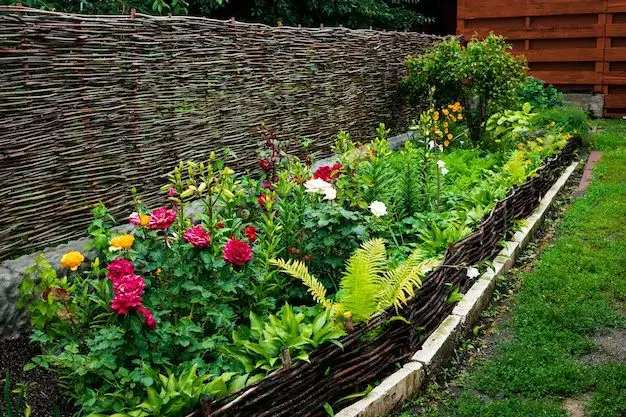Having a vegetable garden can be an extremely rewarding experience. Not only does it allow you to grow fresh, organic produce right in your own backyard, but it also provides a fun hobby and a way to get some exercise outdoors. However, in order to have a successful vegetable garden, you need to protect it from critters who might want to nibble on your plants. The best way to do this is by installing a sturdy, durable fence around the perimeter of your garden.
Page Contents
Should you fence a vegetable garden?
Fencing in your vegetable garden is highly recommended for several reasons:
- Prevents animals from eating your crops – Deer, rabbits, groundhogs, and other wildlife love munching on vegetable plants. A fence blocks access to your garden, protecting it from damage.
- Deters insect pests – Some crawling insects can be kept out with fencing material like chicken wire.
- Provides support for climbing plants – You can grow vining plants like peas and beans on a fence, maximizing your growing space.
- Creates a defined space – A fence allows you to section off an area, keeping your garden neatly contained.
- Looks nice – An attractive, well-built fence lends aesthetic appeal to your landscape.
The security and definition a garden fence provides makes it an essential investment for any vegetable plot, no matter how big or small.
What are the main types of fences for vegetable gardens?
There are several common types of fences that work well for protecting vegetable gardens:
Wire Mesh Fencing
Wire mesh fencing, sometimes called chain link fencing, is made from galvanized or vinyl-coated steel wire woven into a diamond pattern. It comes in rolls and can be cut to size. Wire mesh fencing is very sturdy and provides excellent protection against animals trying to get into your garden. It allows good visibility of your plants. On the downside, it’s not the most decorative option.
Chicken Wire
Chicken wire is lightweight, galvanized steel wire mesh with 1-inch openings. It’s one of the most affordable and easiest materials for enclosing a vegetable garden. The small openings block access by small animals like rabbits. Chicken wire requires support from fence posts. It won’t stop more determined, larger animals like deer.
Wooden Picket Fencing
Classic wooden picket fences made from vertical boards offer an attractive look for gardens. The view of plants isn’t obscured. Wood is also a sustainable, environmentally-friendly choice. Cedar and redwood are preferred woods due to their weather-resistance. But wood requires more upkeep over time than wire or metal fences.
Decorative Metal Fencing
Ornate metal garden fencing offers security with an upscale appearance. Wrought iron, aluminum and steel are common metals used. Intricate patterns allow visibility while preventing animal entry. Decorative metal is one of the most expensive but durable options for garden fencing.
Live Fencing
For a living fence made from plants, options include hedges, espaliered trees, or vining plants grown on a support structure. They provide a natural look but can take time to grow to full size. Evergreen hedges like arborvitae offer year-round protection.
What height fence is optimal?
The recommended fencing height depends on what type of animals you are trying to keep out of your vegetable garden:
- 2-3 feet tall – Keeps out rabbits and groundhogs.
- 4 feet tall – Keeps out most deer and dogs.
- 6-8 feet tall – Needed to deter all deer and large animals.
A 4-foot tall fence is sufficient for many home gardens. Make sure the fence height complies with any local regulations.
What material is best for a vegetable garden fence?
The optimal fencing material for your vegetable garden depends on several factors:
Durability
Long lasting materials like woven wire, welded wire, metal, plastic, masonry, or rot-resistant wood can withstand constant outdoor exposure and last for years. Avoid cheap chicken wire prone to rusting.
Affordability
Compare fencing prices to your budget constraints. Chain link and welded wire are cost-effective options. Ornate metal and wood fencing are premium-priced.
Security
Assess which pests are a threat and choose a material with openings too small for them to pass through. Wire and metal fences provide the most security.
Ease of Installation
Fencing like welded wire attached to metal T-posts is quick to install. Masonry, wood, and decorative metal take more time and skill to erect.
Aesthetics
Regular wire fencing is purely functional. For a beautiful look, wood or decorative metal are visually appealing choices.
Visibility
Minimize blocked views of your garden with wire, picket, or lattice fencing. Solid wood or masonry walls obscure sight lines.
What is the most cost-effective fencing?
Here are some of the most budget-friendly fencing options for vegetable gardens:
Chicken Wire
Basic chicken wire rolls are the cheapest way to fence a garden at around $50 for a 50-foot roll. The thin wire won’t last decades but provides temporary, affordable protection.
Welded Wire Fencing
Welded wire fencing offers rigid strength at a reasonable price, with a 4 foot x 50 foot roll costing around $125. It should last over 10 years.
Live Fencing
Grow your own fence from plants. Bushy hedging plants like arborvitae can create a living border for under $10 per plant.
Repurposed Materials
Cut costs by sourcing used fencing from Craigslist and Facebook. Repurposed household items like old bed frames or laundry racks also work.
Conclusion
Installing a protective fence around your edible garden is one of the best investments you can make. Fencing leads to higher yields by keeping vegetable-munching critters at bay. When choosing fencing, consider the pests you need to deter, cost, durability, aesthetics, and ease of installation. Wire, metal, and wood are common fencing materials, with chicken wire and welded wire being budget-friendly options. Aim for at least 4 feet tall. Proper garden fencing makes growing your own healthy, homegrown produce much more successful.
